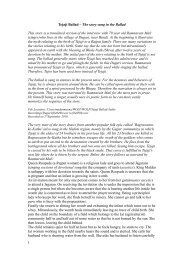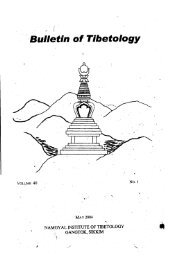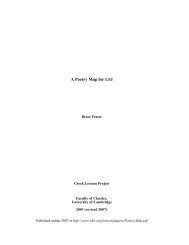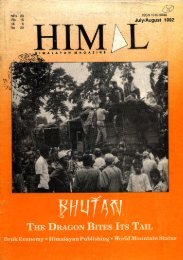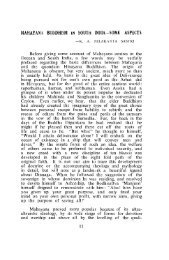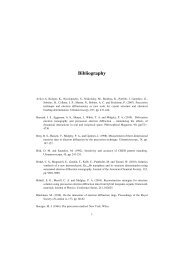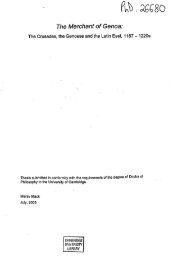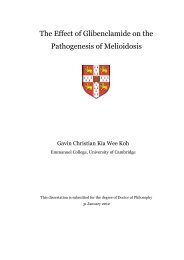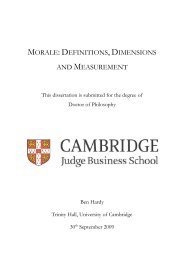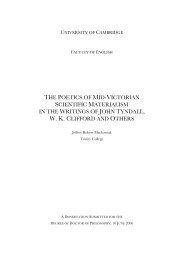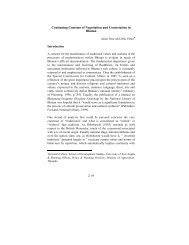Sahasra Buddha
Sahasra Buddha
Sahasra Buddha
You also want an ePaper? Increase the reach of your titles
YUMPU automatically turns print PDFs into web optimized ePapers that Google loves.
SAHASRA BUDDHA<br />
N irmal C. Sinha<br />
The only image pennitted in Theravada temples is that of the historical<br />
<strong>Buddha</strong>, Gautama Sakya Muni. In Mahayana temple$-in the Himalayas,<br />
Tibet and Mongolia-besides the historical <strong>Buddha</strong> designated simply<br />
<strong>Buddha</strong> (T. Sangay) or Sakya Muni cr. Sakya-Thubpa), there would be many<br />
images ranging from Three to Thousand according to size and resources of<br />
temple or monastery concerned, <strong>Sahasra</strong><strong>Buddha</strong>(T. Sangay T ongda) was no<br />
doubt the ideal count by 9th century A.D. when Mahayana pantheon was<br />
sculptured and painted in Samye (Central Tibet) and Tun Huang (northern<br />
outpost of ancient Tibetan empire). Sanskrit-Tibetan Lexicon<br />
Mahavyutpatti (Circa 820 A.D.) testifies to the usage of<strong>Sahasra</strong><strong>Buddha</strong>as<br />
then current. In BhadraJcalpa Sutra, now aVi!lilable only in Tibetan<br />
translation, the number recorded is 1000.<br />
The figures are those of <strong>Buddha</strong>s and Bodhisattvas, historical ar. J<br />
legendary, besides the Goddesses. Figures of patrons and protectors of<br />
Dharma would be. permissible in paintings and iconography as such<br />
persons no doubt had taken the Refuge in Dharma (T.Cho) and believers<br />
would admire them if not adore them as Bodhisattvas cr. Changchub<br />
Sempa).<br />
Since Dharmaraja cr. Chogyal) was Bodhisattva par-excellence and<br />
Asoka Maurya was the first and greatest Dharmaraja, Mahayana ')(lntheon<br />
had a place of high honour for Asoka. FollOWing the Indian tradition the first<br />
and greatest Chogyal of Tibet, Song-tsen Gampo was apotheosised.<br />
Mahayana was preached by Nagarjuna a contemporary of the Kushanas in<br />
North India and the Sotavahanas in South India. This preaching by<br />
Nagarjuna was described by Mahayana believers as Second Turning of the<br />
Wheel of Law and Nagarjuna was in Mahayana tradition the Second<br />
<strong>Buddha</strong>. Nagarjuna and the Mahayana exponents like Aryadeva, Asanga,<br />
Vasubandhu, Dignaga and Dharmakirti were thus placed high in Mahayana<br />
pantheon. In Tibetan tradition Guru Padmasambhava, Atisa Dipankara and<br />
Tibetan saints like Marpa and Tsongkhapa were included in the pantheon<br />
and placed as high as Gautama <strong>Buddha</strong> or Nagarjuna, In fact a Guru like<br />
Padmasambhava or Tsongkhapa would dominate the gallery of icons orthe<br />
In Romtln transcription diacritical marks for Sanskrit and Tibetan word8an) omllted, exceptior<br />
quotes from other writers. SC]lskrit word8 an) spelt thus: TathaQata (for TathliQata). Aaokll (for<br />
Asoka) or Nirmanakllya (for Nimuma!t5ya). Tibetan words are transcribed as pronounced thus:<br />
Lama (Blama), SanQay (for SanQS-n;yas) or Chcqyal (for Chhos-rQYlll).<br />
5
Sanskrit and PaU Texts Cited<br />
12
DHARMAKAYA AMIT ABHA<br />
14<br />
,
SAMBHOGAKAYA AVAUJ
NIRMANAKAYA SI\KY AM.JNI<br />
16
PADMASAMBHAVA<br />
17
MIlAREPA<br />
19
TUNG SHA<br />
Thirtyfive <strong>Buddha</strong>s who receive confession
GAUTAMA SAKYAMUNI & OTHER BUDDHAS<br />
including celestial <strong>Buddha</strong>s<br />
Bodhisattvas and Master Exponents
TSHOG ZHING<br />
Assembly of <strong>Buddha</strong>s: Tsongkhapa in centre
SIPA'I KHORLO<br />
Wheel of Life depicting six worlds of existence



